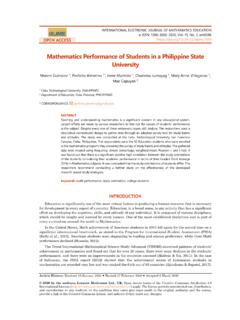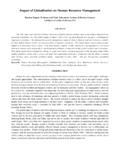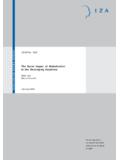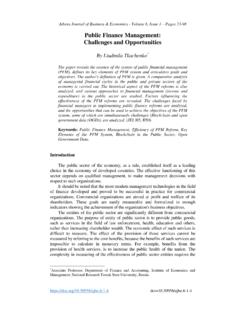Transcription of Globalization and Regionalization: Institution Aspect - IEJME
1 CORRESPONDENCE Olga V. Trubetskaya 2016 Matveev et al. Open Access terms of the Creative Commons Attribution International License ( ) apply. The license permits unrestricted use, distribution, and reproduction in any medium, on the condition that users give exact credit to the original author(s) and the source, provide a link to the Creative Commons license, and indicate if they made any changes. Introduction The most important trends in contemporary world development are on the one hand, the process of Globalization and on the other the increasing activity of regional integration. Globalization and regionalization are some of the most controversial concepts, which are reflected in the works of P. Krugman (1995), Globalization and Regionalization: Institution Aspect Yury V.
2 Matveeva, Elizaveta N. Valievaa, Olga V. Trubetskayaa and Alexander G. Kislovb aSamara State University of Economics, RUSSIA; Russian State Vocational Pedagogical University, RUSSIA. ABSTRACT The urgency of the analyzed problem is due to the fact that regionalization and Globalization have a dual nature and depend on the institutional system, which, in turn, affects the establishment of new rules in the economic space in which interact businesses. The purpose of the article is to justify the fact that the institutional Aspect of Globalization and regionalization is, above all, in the establishment of new rules and norms of the economy that affect all businesses, and one of the key roles is performed by innovation and investment institutions.
3 The main methods in the study of this problem is the dialectical method, which allows identifying trends in the development institutions at the regional level. Results: the article proves that the development of modern market institutions is associated with the stimulation of innovation activity in the regions and the creation of innovation systems in them, the effectiveness of which depends on the degree of interconnectedness and interdependence of the national innovation system, which corresponds to the Globalization processes. The data of the article may be useful in determining institutions of the Samara region that promote economic development and competitiveness of the region, as well as practical development of managerial decisions related to improving the efficiency of the use of economic and administrative resources.
4 KEYWORDS ARTICLE HISTORY Globalization ; institutional environment; innovative development institutes; regionalization; social and economic development centers Received 14 April 2016 Revised 29 June 2016 Accepted 12 July 2016 IEJME MATHEMATICS EDUCATION 2016, VOL. 11, NO. 8, 3114-3126 OPEN ACCESS IEJME - MATHEMATICS EDUCATION3115 Y. Shishkov (2001), S. Glazyev, E. Naumov& A. Ponukalin (2011), I. Osadchaya (2002), I. Vasquez (2002), S. Marginean (2015) as well as A. Mohaghegh (2016). Globalization affects economic, political processes at the global level, but regionalization involves, first of all consideration of various events and the needs of specific areas of the country. Globalization and regionalization are contradictory unity as their goal in some cases may be the same, and in some can be quite divergent.
5 Both of these processes form new institutions in the global economic space which determine the actions of macroeconomic subjects, thus there is transplantation of institutions in most developed countries, which in turn causes a strong socio-economic dependence of recipient countries, hinders their development and enhances the technical -economic underdevelopment, reduces welfare, and increases economic and political risks. These problems could be solved by the development of modern market institutions at the regional level, especially in innovative and investment area. The features of these institutions is the current structure of regional norms and relations, as well as innovation and industrial clusters.
6 Materials and Methods The authors used the following basic scientific approaches to reveal the contents of the topic while carrying out scientific research: - Dialeсtiс-materialistic approach (to consider a dual nature of Globalization and regionalization processes as well as the institutional and economic content of regional development and management); - institutional approach (to develop management process with the help of regional development as a design process of institutional alternatives which provide regional innovative and investment system formation and development as a component of national innovative system); - Interdisciplinary approach (to identify institutional alternatives using the interaction of various scientific cognition spheres).
7 Also, the following methods were used in the course of the research process: theoretical (analysis and synthesis, deduction, generalization, analogy method); empirical (the study of experience in the region, regulatory documents); methods of mathematical statistics and graphic results. Results The world practice shows that modern Institution development is connected with the innovative activity stimulation in the regions that, in particular is confirmed in the main strategic country document, the Concept 2020 which represents innovative and social orientation of regional development within innovative and social direction of long-term social and economic Russian Federation development in general. Such formulation of one political doctrine aspects of regional development claims that innovative and social vectors form one interconnected unit, as well as that opportunities to achievement purposes of the country development are included in opportunities of the regions.
8 So, according to the famous Russian economist S. Glazyev, E. Naumov & A. Ponukalin (2011), the task is to organize their realization effectively, both in each certain region, and in integration processes. 3116 Y. V. MATVEEV ET AL. The strategy of the regional policy that is presented in the Concept 2020 is based on the fact that an innovative and socially oriented development way assumes multipolar country territory development and new zones formation for advancing development. Within such scenario the success depends on the achievement of a synergetic effect derived from the complexity of the formation conditions of interfaced clusters in the production of a new technological way, on the coherence conditions of macroeconomic policy with the priorities of long-term technical and economic development aiming at positive social dynamics (Khasaev, Matveev & Matveev, 2014).
9 In accordance with regional development strategy, configuration of spatial development is to be not attached closely to developed power-raw zones and financial centers; there have to be new innovation growth centers that rely on human and technological potential concentration. New economic growth centers are supposed to be developed and it has to lead to regional inequality decrease and the reduction of economic resources superconcentration in capital agglomerations (however, in medium-term prospect there is the tendency to advancing development of capital agglomerations and the main financial and innovative resources are concentrated in them). At the same time, the formation of new advanced industry centers and modern service economy will give an impulse to technological modernization development of historically formed processing branches of mechanical engineering, metallurgy, chemistry and petrochemistry, aviation and light industry centers which are concentrated in large cities in the central part of Russia.
10 There is an obvious relation between the innovative development and such regulatory mechanisms that authorities use, as crediting and subsidies, innovative activity support, leasing activity support, creation of coordination councils, grants and awards, taxation, creation of registers and lists to support enterprises. Today regional centers have been already created where social and economic modernization is carried out according to the state social development strategy. In particular, the Samara region is one of the strongest industrial regions of the country with diversified economy, high processing productions concentration and powerful scientific and innovative potential which is also an industrial center of Russia.









